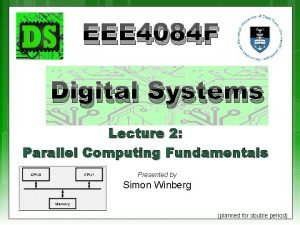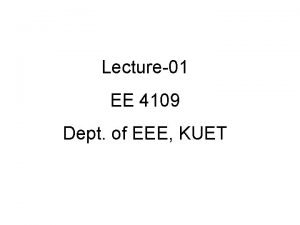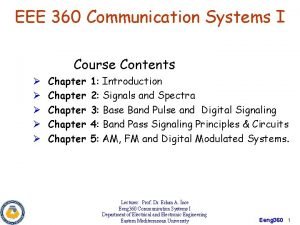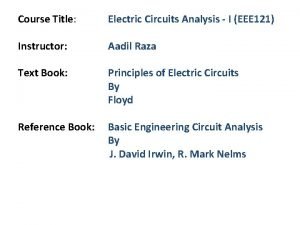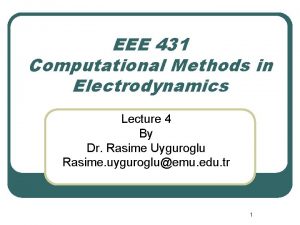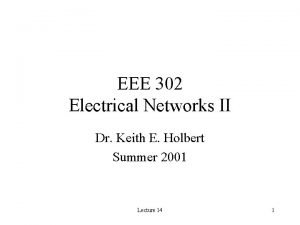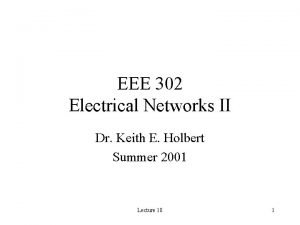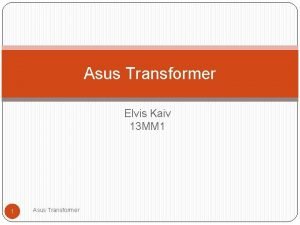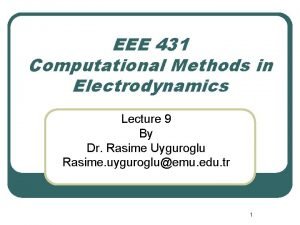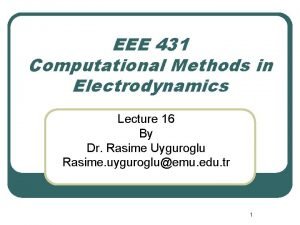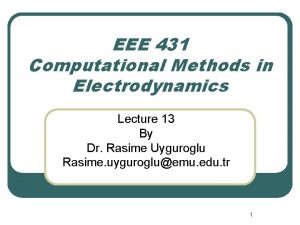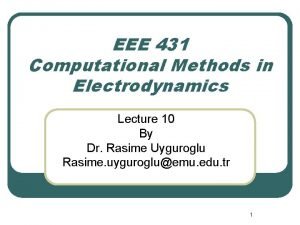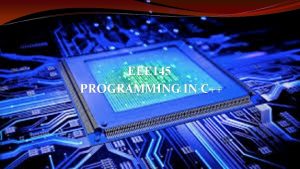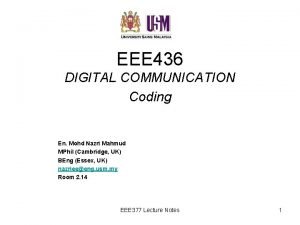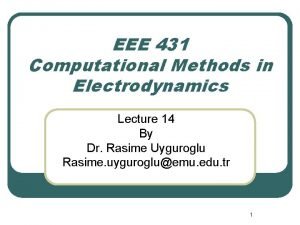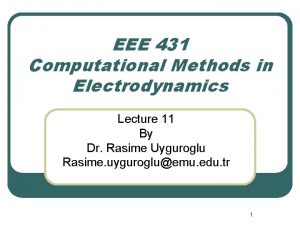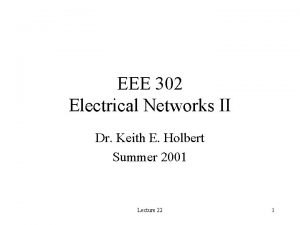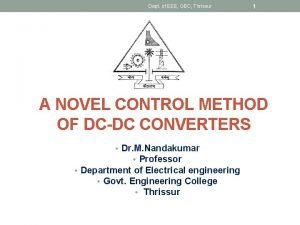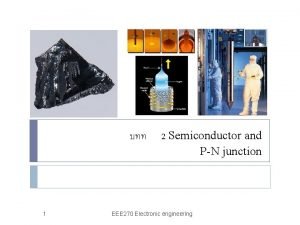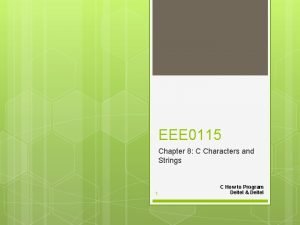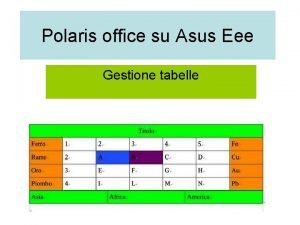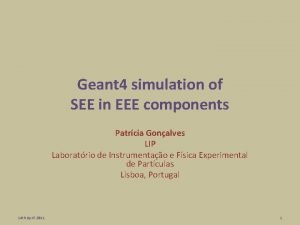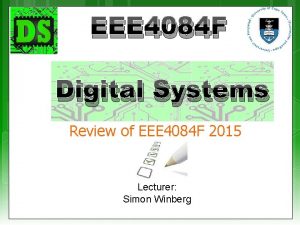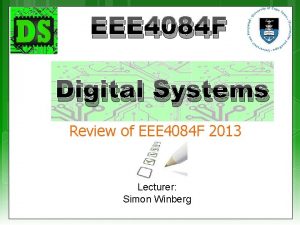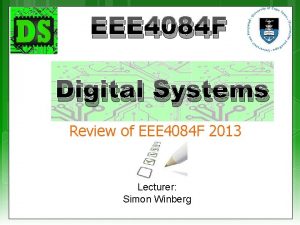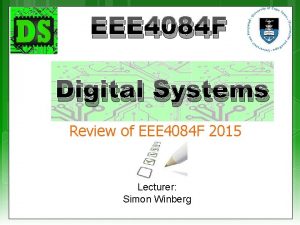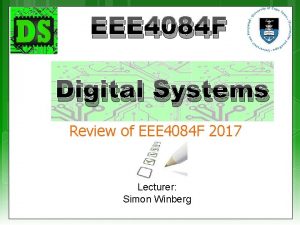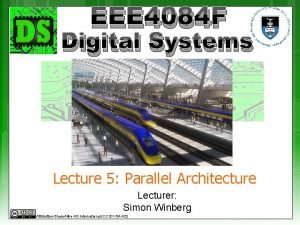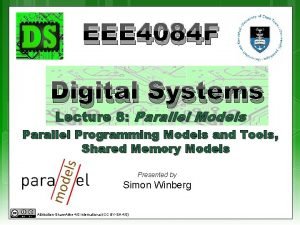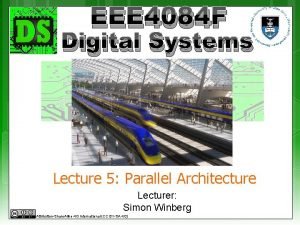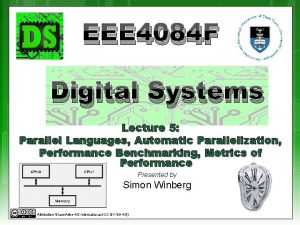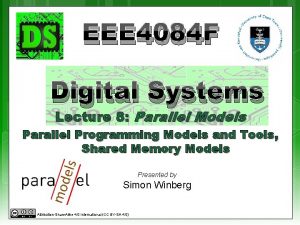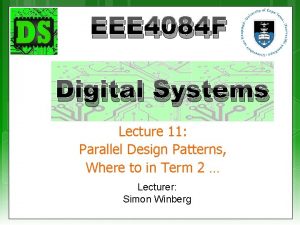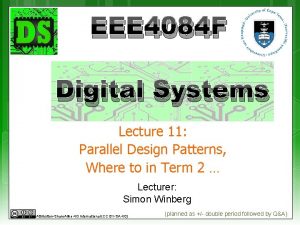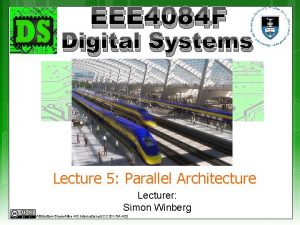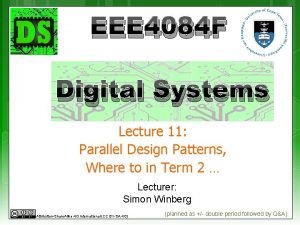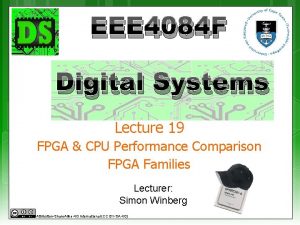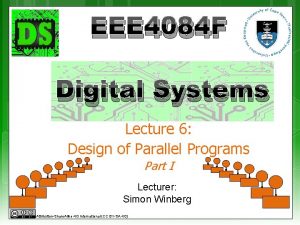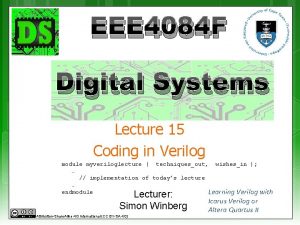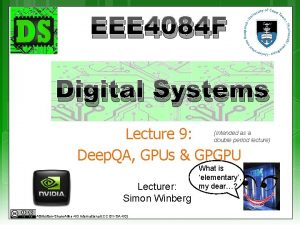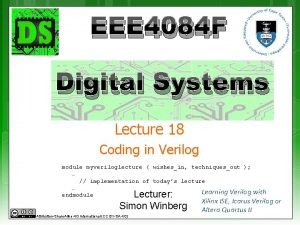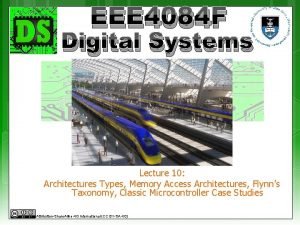EEE 4084 F Digital Systems Lecture 11 Parallel



































- Slides: 35

EEE 4084 F Digital Systems Lecture 11: Parallel Design Patterns, Where to in Term 2 … Lecturer: Simon Winberg Attribution-Share. Alike 4. 0 International (CC BY-SA 4. 0) (planned as +/- double period followed by Q&A)

Lecture Overview Parallel design patterns Terms Where to in Term 2

Parallel programming design patterns Program design pattern A general, reusable solution to a commonly occurring software design problem. A design pattern is usually not a complete design that is directly transformed into code. A design pattern is more a description or template describing how a design problem can be solved for a wide range of instances. Object-oriented design patterns (i. e. C++ and Java) often involve classes, possibly class templates, which comprise initial attributes, methods and relationships between classes. These can be inherited and incorporated into a new application using a little additional code, and without re-implementing the entire pattern.

Commonly used design patterns Pipeline Replicate & Reduce Repository Divide & conquer Master/slave Work queues Producer/consumer flows Other patterns and details: http: //www. cs. uiuc. edu/homes/snir/PPP/

Assigned reading “Parallel Programming Patterns” (Power. Point presentation) by Eun-Gyn Kim, 2004. Available at: http: //www. cs. uiuc. edu/homes/snir/PP P/patterns. ppt Copy has been placed on Vula, see Readings folder in resources

Quick overview of Common patterns EEE 4084 F

Master/Slave master slaves Master dispatches processing jobs to slaves. Slaves either store results (locally or to communal storage) or send results back to master.

Work queues Producer Consumer Producer work Producer work Shared Queue Consumer Producers create new work jobs that need to be performed at a later stage. These jobs are removed from the queue by consumers, on a first come first served basis, and completed by the consumer. Results may be dispatched to further processing or somehow integrated towards the end of the program.

Produce/consumer flows Parallel tasks: Producer Consumer The producer consumer flows pattern is similar to the work queues, except each procedure is coupled with a consumer, without going through a queue. This approach may work better if the producer and consumer need some form of collaboration (e. g. , making decisions, etc) before the consumer starts work. For example the producer may ‘discuss’ with the consumer where its results are going to be stored and negotiate the process speed and Qo. S required.

Replicate & reduce Master/global storage Initiator Local storage REPLICATE Local storage … Task A Task B Task X REDUCE Solution Starts by copying the data to local storage for each node, which is then operated on by the tasks. Results are collected to form the solution.

Repository pattern Various computations applied to and/or saved to data in a central repository. Repository controls access and maintains consistency, e. g. same task cannot work on same data items at the same time. Task A Communal repository Task B Task C asynchronous access … Task C Task X

Divide and conquer Task 1. 1 (handles sub-problem) Task 1 (handles sub-problem) divide (handles sub-problem) Initiator / Main divide problem Task 2. 1 Task 2 (handles sub-problem) Task 1. 2 divide (handles sub-problem) Task 2. 2 (handles sub-problem) merge Task 1 (merging solutions) Task 2. 1. 1 (handles sub-problem) divide merge Solution (problem Conquered!) … Task 2. 1. 1 (handles sub-problem) Many ways this can be implemented. A common method: any task(e. g. , Task 1) that has too much work to do splits into two or more subtasks (e. g. , Task 1. 1 and Task 1. 2) which then do the work in parallel, send the results back to Task 1 and then Task 1 merges the results and either sends its result back the initiator or to a task that it has been commanded to return its results to. Note, often Task 1. 1 would actually be Task 1 (i. e. it spans off helpers but also done some of the work itself).

Hi! Pro je ct-b ase Lea d rnin g is For me Where to in term 2 EEE 4084 F Digital Systems Diddle Dee?

Where to in Term 2 Term The 2 involves: YODA Project (design, implement and test Your Own Digital Accelerator) FPGA-based application accelerators Reconfigurable computing More hardware & HDL issues

Some terminology… EEE 4084 F

Application Accelerator? Slow App add-on card (or reconfigurable Accelerator co-processor) used to speed-up processing for a particular solution A GPU is a typical example Zo om ! An

Application Accelerator? An application accelerator may well be a type of computer system itself – possibly a stand-alone network-linked computer Generally, it is assumed to be an addon card or peripheral that software on a host PC wants to connect to in order to delegate processing operations

Other Important Terms Verification These terms are not merely theoretical terms to remember, but relate directly to your project. Validation Testing Correctness proof Not something done in the project (but if you want to, you can experiment with doing a correctness proof if you are keen)

Verification and Validation (V&V) Two terms you should already know… Verification “Are we building the product right? ” Have we made what we understood we wanted to make? Does the product satisfy its specifications? Validation “Are we building the right product? ” Does the product satisfy the users’ requirements Verification before validation (except in duress)… While it would be nice to be able to validate before verifying, doing so would mean your specifications and design may be wrong in the final version (obviously this sometimes happens in practice due to insufficient time for proper validation) Sommerville, I. Software Engineering. Addison-Wesley, 2000.

Verification before validation The RC engineer (i. e. , you) are effectively designing both custom hardware and custom software for the RC platform Before attempting to make claims about the validity of your system, it’s usually best practice to establish your own (or team’s) confidence in what your system is doing, i. e. be sure that: The custom hardware working; The software implementation is doing what it was designed to do; and The custom software runs reliably on the custom hardware.

Verification Checking plans, documents, code, Focus of requirements and specifications project Is everything that you need there? Algorithms/functions working properly? Done during phase interval (e. g. , design => implementation) Activities: Review meetings, walkthroughs, inspections Informal demonstrations Focus of project

Commonly used verification methods 1. Duel processing, producing two result sets 1. 2. 3. One version using PC & simulation only; Other version including RC platform Assume the PC version is the correct one (i. e. , the gold measure) Correlate the results to establish correlation coefficients (complex systems may have many different sets of possibly multidimensional data that need to be compared) The correlation coefficients can be used as a kind of ‘confidence factor’

Validation Testing Focus of project of the whole product / system Input: checklist of things to test or list of issues that need to have been provided/fixed Towards end of project Activities: Formal demonstrations Factory Acceptance Test

Testing and Correctness proofs Testing refers to aspects of dynamic validation in which a program is executed and the results analysed Generally Correctness proofs / formal verification More a mathematical approach Exhaustive test => specification guaranteed correct Formal verification of hardware is especially relevant to RC. Formal methods include: Model checking / state space exploration Use of linear temporal logic and computational tree logic Mathematical proof (e. g. proof by induction)

Correlation General definition of “correlation”: Correlation determines whether values of one variable are related to another Variables: PC/gold program; RC program Obviously, its probably still a good idea, before going to the effort of correlation results, to visually inspect the target system (RC platform) results to see if they look sufficiently close to what is expected.

Dependent and Independent variables: Can be controlled or manipulated (i. e. , the software and custom RC hardware) Input data for your program Processing tasks to perform Dependent Variables variables that you cannot manipulate Value of these variables are dependent on the independent variables

Performing Correlations A correlation is performed by a set of comparisons (seeing how one variable changes as others variables change) * Correlation coefficient (r): A measure for the direction and strength of a relation between two variables (say x and y) r is a value between -1 and +1 Positive vs. negative correlation… * Made easier if you know which are dependent and independent variables

Performing Correlations Correlation coefficient (r): correlated with y r( x , y ) r = +1 : perfect correlation. As x changes, y changes in the same proportionate magnitude and direction r = -1 : total negative correlation. As x changes, y changes in same proportionate magnitude but opposite direction r = 0 : no correlation. Week or non-existent relationship between x and y | r | < 1 varying degrees of correlation x

Short Exercise Think of designing an application accelerator for calculating Fibonacci numbers. fib(4) = 3 ! fib(3) = 2 fib(2) = 1 fib(1) = 1 4 PC 4, 3 Fib device What sort of design pattern would suite such a device? Considering there would be a PC sending requests 1000 s of requests and receiving paired results (input: output) in an unblocking manner (as illustrated above). If you went the way of a designing a processor core to do this and have multiple of these cores on the digital accelerator, what instructions would each core execute? What other parts would be needed to make it a functional system? Do some rough diagrams and discuss with your class mates. Fun link to try for a visual Fibonacci calculator: http: //php. bubble. ro/fibonacci/

Correctness Proof Example: Using proof by induction . . But before launching into this, a quick question:

Ask the audience question You hopefully all remember the Quick Sort algorithm… Considering the design patterns given earlier which one of these patterns is most relevant to the design of Quick Sort ? Options: A. Pipeline B. Replicate & Reduce C. Repository D. Divide & conquer E. Master/slave F. Work queues G. Producer/consumer flows … I’ll make it slightly easier by cutting down the options

Proof by correctness example Using proof by induction to validate operation of the Quicksort algorithm https: //www. youtube. com/watch? v=4 Y 8 Kow. ZWG 78 *Related topic: The Quick Sort Algorithm - https: //www. youtube. com/watch? v=3 DV 8 GO 9 g 7 B 4

Considerations for tests/exams You should know the general concept and reasoning behind the use of correction proofs in relation to digital system design (especially considering the potentially huge risk reduction that can be achieved in this way for high-stakes and safety-critical applications) It is recommendable that you understand the principle of proof by induction (which you’ve probably/should have done to ad nauseam) but you won’t be asked to do any complex proof by induction on algorithms as that would be outside the scope of this course.

Next lecture The Project and Intro to reconfigurable computers

Disclaimers and copyright/licensing details I have tried to follow the correct practices concerning copyright and licensing of material, particularly image sources that have been used in this presentation. I have put much effort into trying to make this material open access so that it can be of benefit to others in their teaching and learning practice. Any mistakes or omissions with regards to these issues I will correct when notified. To the best of my understanding the material in these slides can be shared according to the Creative Commons “Attribution-Share. Alike 4. 0 International (CC BY-SA 4. 0)” license, and that is why I selected that license to apply to this presentation (it’s not because I particulate want my slides referenced but more to acknowledge the sources and generosity of others who have provided free material such as the images I have used). Image sources: patchwork – flickr Command Conquer– from http: //caboose 4 ever. deviantart. com/ (CC-ASA 3. 0) Conductor - Wikipedia (open commons) Yoda sketch - fickr Band of musicians – Pixabay http: //pixabay. com/ (public domain)
 Q6 4084
Q6 4084 01:640:244 lecture notes - lecture 15: plat, idah, farad
01:640:244 lecture notes - lecture 15: plat, idah, farad Cloud computing lecture
Cloud computing lecture Eee kuet
Eee kuet Analog communication
Analog communication Ankara university
Ankara university Eee 121
Eee 121 Eee 431
Eee 431 Eee 302
Eee 302 Eee 302
Eee 302 Tahvel.edu.eee
Tahvel.edu.eee Eee 431
Eee 431 Eee 431
Eee 431 Eee 431
Eee 431 Eee 431
Eee 431 Eee 145
Eee 145 Lecc
Lecc Huffman coding
Huffman coding Eee 431
Eee 431 Eee 431
Eee 431 Eee g
Eee g Eee 302
Eee 302 Spherical differential
Spherical differential Eee
Eee Animacionet
Animacionet Eee
Eee Android (linux-based)
Android (linux-based) Hku eee lab
Hku eee lab Pdfcute
Pdfcute Schematic arrangement of diesel power plant
Schematic arrangement of diesel power plant Eee
Eee Eee components
Eee components Eee office
Eee office Eee office
Eee office Eee metu
Eee metu Eee components
Eee components
